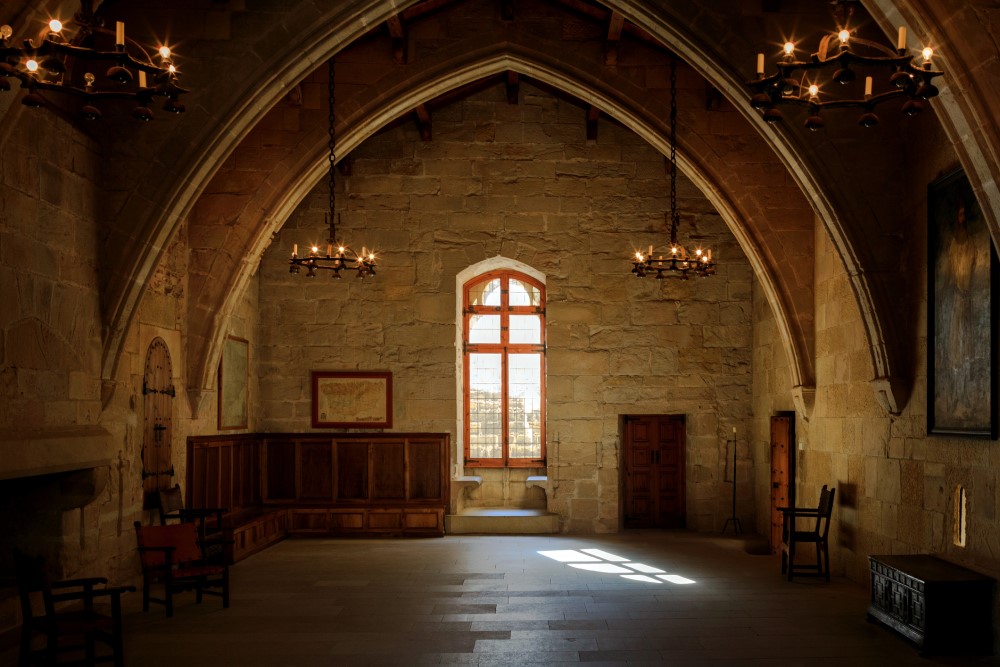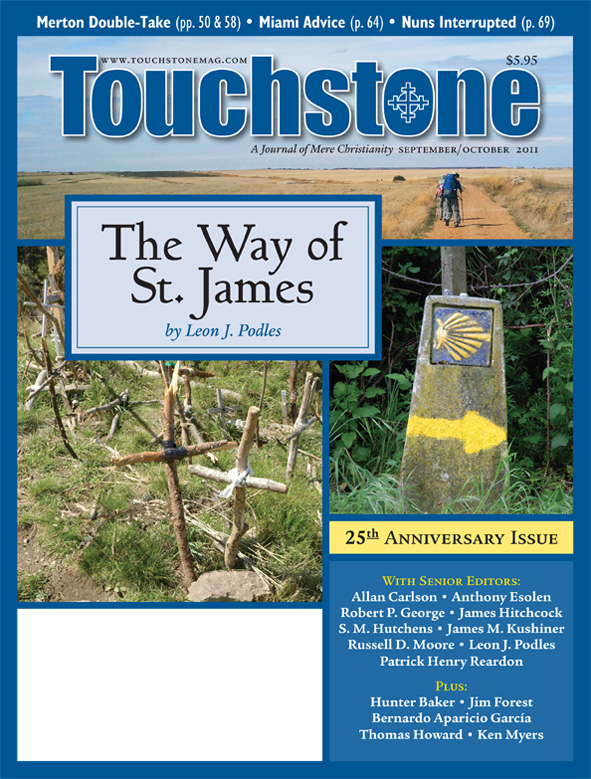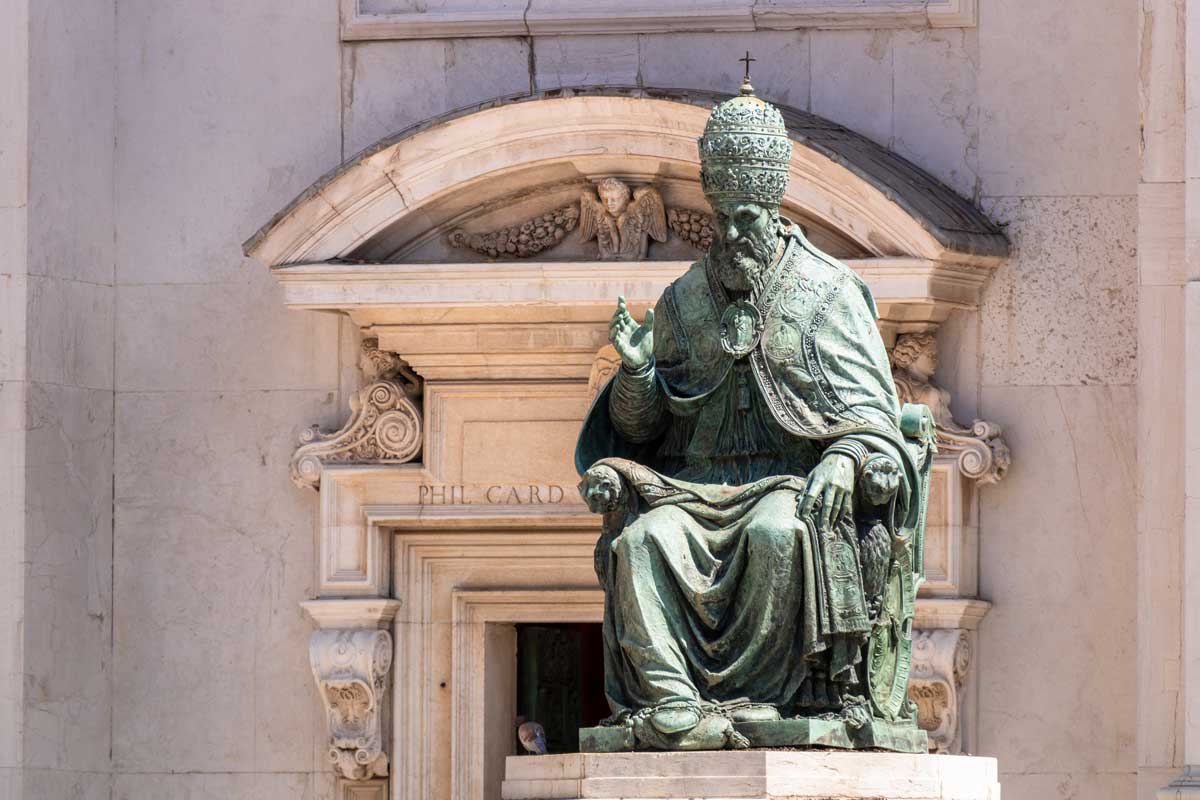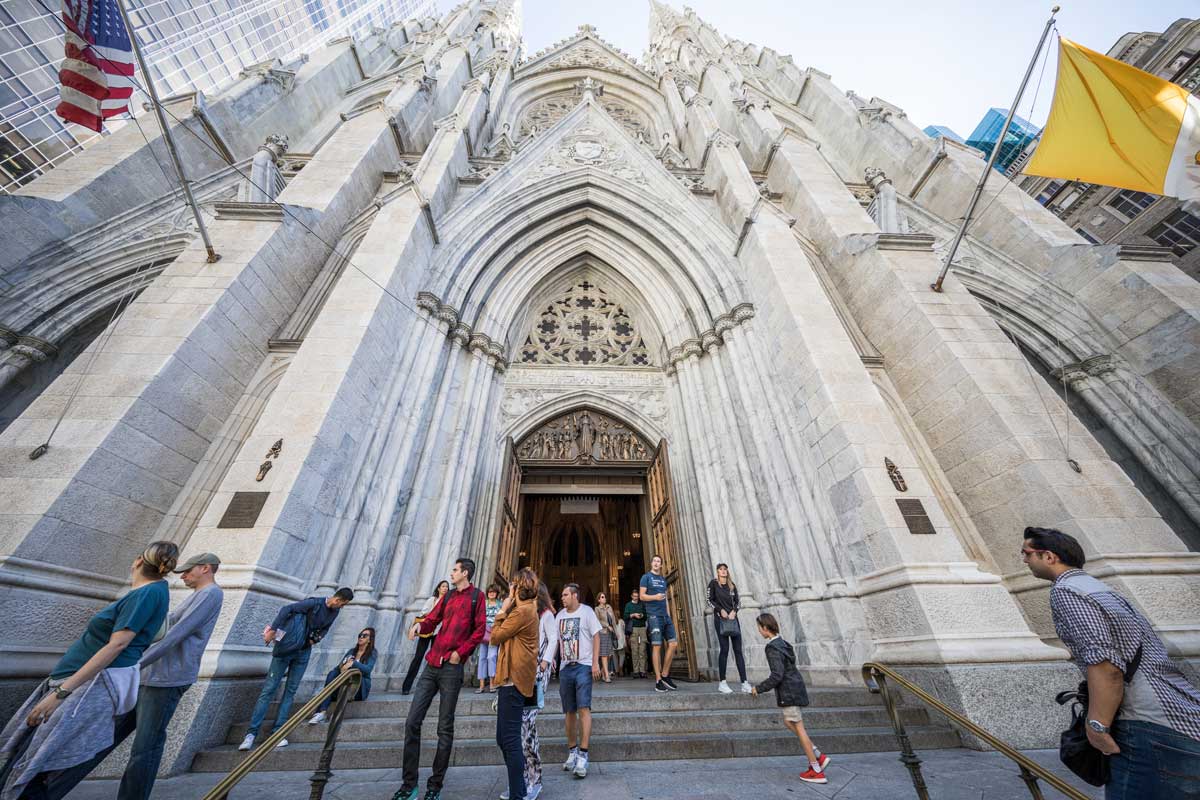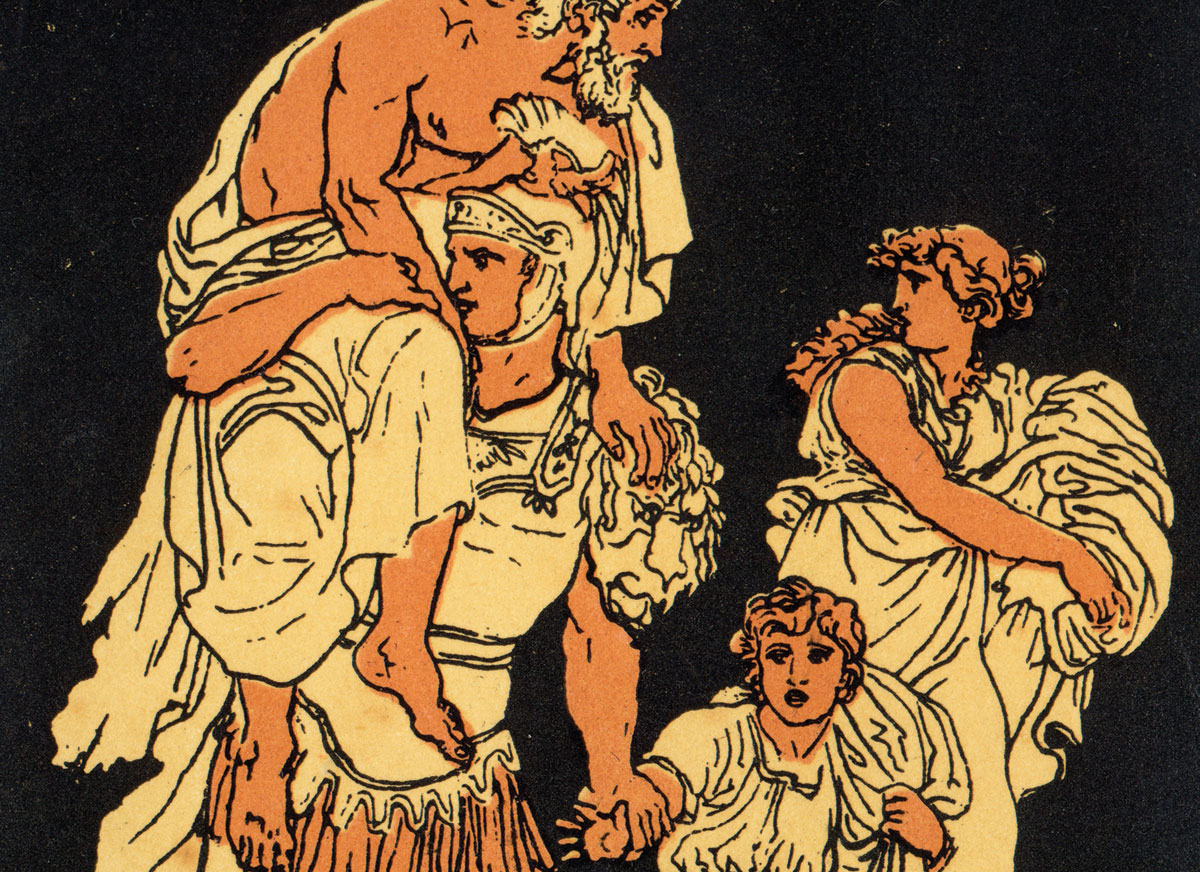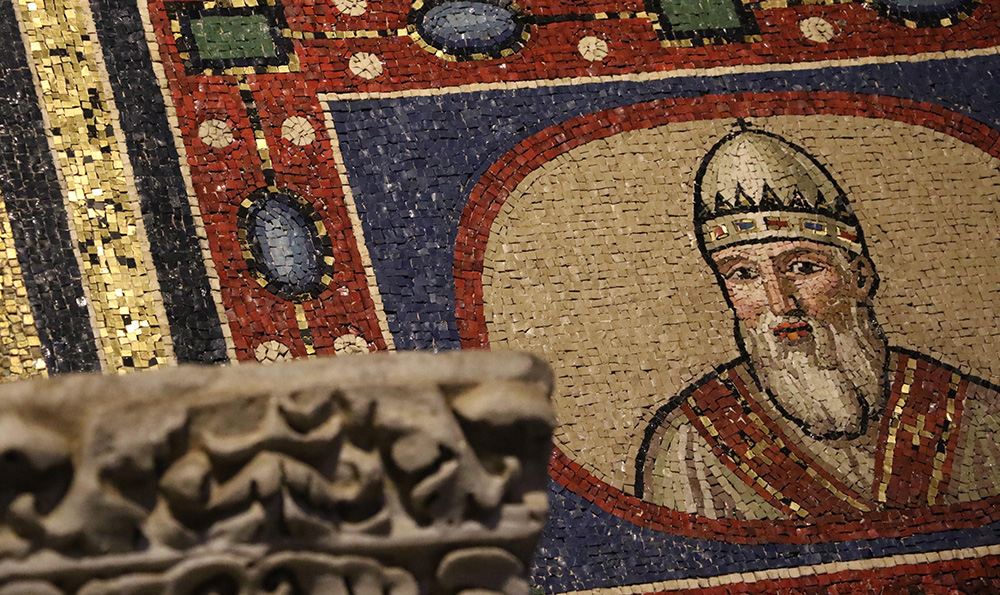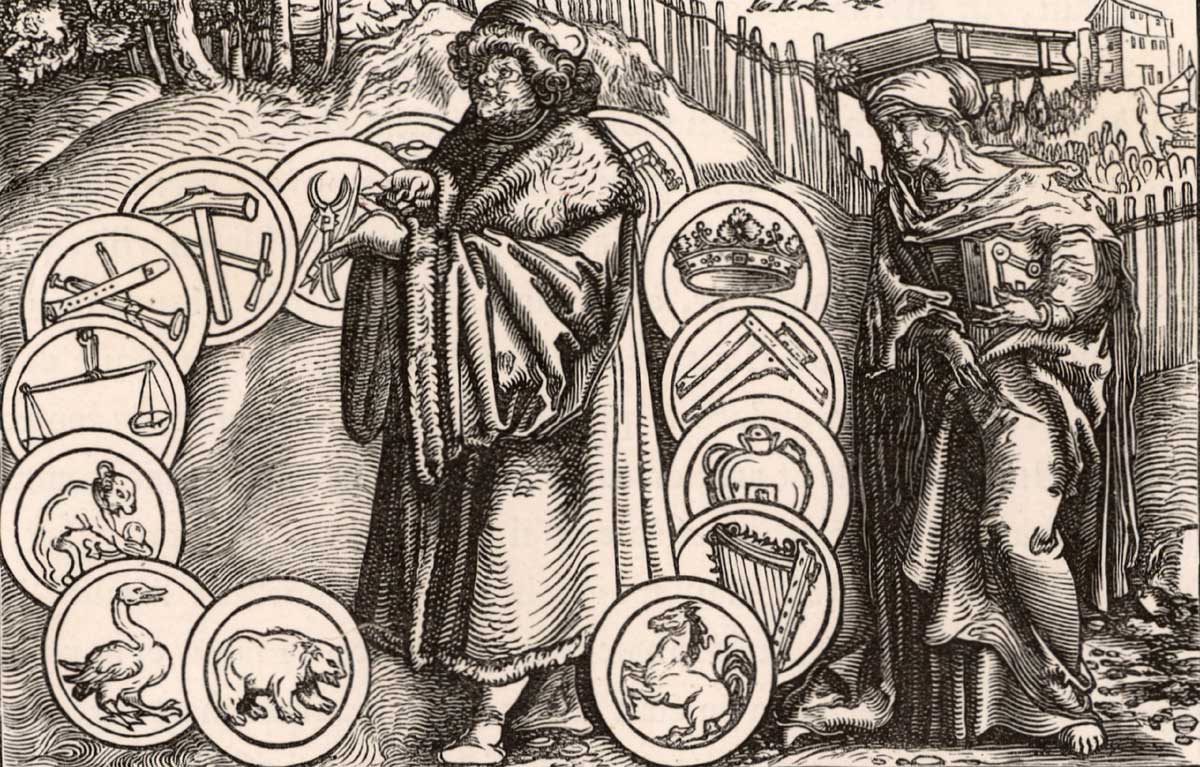Feature
A Many-Storied Monastic
A Critical Memoir of Thomas Merton at Gethsemani Abbey
In the late afternoon of December 17, 1968, Thomas Merton’s body was laid to rest at his Trappist monastery, Gethsemani Abbey, in Kentucky. During the hour that immediately preceded the funeral Mass, the bier was placed at the top of the nave in the monastery church, where—in accordance with ancient monastic custom—two monks stood and recited the Psalms for the repose of Merton’s soul.
I was one of those monks.
During the ensuing four decades and more, friends have repeatedly asked me to write down personal memories of that extraordinary man, whom I knew during the last thirteen years of his life. Although I cannot imagine adding anything new or significant to the vast material recorded in the endless stream of books and articles written about Merton since that time, I have at length determined to jot down a few recollections, whatever their worth.
This is not an introduction to Thomas Merton, of which many are already available, but a short collection of personal memories, arranged more-or-less as they come to me, along with a critical assessment or two.
I have begun them by placing myself, once again, at Merton’s bier, just before the funeral, because the images of that hour are most vivid in my mind, and it truly was my last “contact” with him.
Ironies & Paradoxes
Like everyone else associated with Merton, I was stunned by several ironies, incongruities, contradictions, and points of paradox that attended his death. Some of these, I’m afraid, may have distracted my praying of the Psalms that day.
Most unusual was the large group of visitors who journeyed to the monastery for Merton’s funeral. This truly was extraordinary. With few exceptions, we were quite unaccustomed to seeing many non-monastics at our funerals. During my years at the abbey, we buried between twenty and thirty of the brethren, I suppose, nearly all of them octogenarians, men who had long outlived their families and the friends from their earlier life. So, except for the postcard obituaries mailed to other houses of the Trappist order, the death of a monk was scarcely noticed outside his monastery. Dom James Fox, Gethsemani’s abbot during most of my time, was fond of summing up their lives as “unknown, unheralded, and unsung.”
Merton, however, was famous—perhaps the most widely read “spiritual writer” of his time and arguably the most celebrated monastic figure of the twentieth century. Consequently, all the wire services carried the news of his passing, and his obituary appeared in newspapers and journals around the world. (Newsweek—or was it Time?—ran a double obituary of Merton and Karl Barth, who died on the same day, December 10, 1968.) Consequently, quite a number of visitors were in attendance at the funeral.
Other points of irony were discernable in the circumstances surrounding Merton’s death, coincidences that drew attention to various aspects of his personality and preferences. For instance, the manner of his death—by electrocution—put many of us in mind of Merton’s well-attested “impracticality” and his relative incompetence in matters mechanical. Indeed, the man’s mechanical unsophistication—he typed his scores of books with two fingers—proved to be, on occasion, nothing short of dangerous.
For instance, a gaping hole on the long north section of the monastery’s enclosure wall—an opening roughly the width of a truck—testified to Merton’s uncertainty respecting the proper function of a brake. Also, there was a harrowing story of novices nearly decapitated by long, two-handed saws that were laid across a jeep—blades forward—when Merton, following the driving method he knew best, floored the accelerator and released the clutch with all possible speed. The jeep violently lurched a few feet and stopped dead. Young monks crossed themselves and blessed a merciful Providence.
Given Merton’s lack of sophistication with mechanical things, none of us was surprised to learn that faulty wiring on a fan had brought about his death. This accident could have befallen any of us, of course, but to this day I am not convinced Merton had a clear idea what electricity was or how it worked.
Ironically, even Merton’s burial involved the use of electricity—a fact that would have driven him, I have no doubt, to utter distraction and bedevilment. He doubtless expected to be buried just like all the other monks: His body would be washed, clothed in the monastic cowl, and placed in an open bier—no casket—with handles for the pallbearers. There would be no embalming, and the funeral would take place the day following his death. After the funeral Mass, he would be carried in solemn procession out to the cemetery, the monks singing “When Israel went forth from Egypt.”
The bier would be set down beside an open grave. At this point, the monastery’s Infirmarian would climb down a ladder into the grave, where he would await the lowering of the body on a sort of sling, held by four other monks standing above the four corners of the grave. Next, the Infirmarian would lay the body right onto the clay, place a napkin over the face, and climb back up out of the grave. Then, while some monks chanted more Psalms, others would fill in the grave. That was—and still is—the normal procedure for the burial of a Trappist monk.
Not Merton. Dying abroad, he was conveyed to the abbey in a steel casket, which was deposited finally on a mechanical contraption set over the grave. At the appropriate time, a local mortician flipped the electrical switch on this device, which began to buzz and hum, as Merton’s remains were mechanically lowered into the Kentucky sod. This spectacle left several of the brethren shaking their heads or rolling their eyes, and the same thought was in everyone’s mind: “Good heavens! He would hate this.”
A light, misty rain began to fall. In the months to come, our dear friend, Father Dan Walsh (well known from The Seven Storey Mountain) advanced the claim that our damp garments—in apparent emulation of Gideon’s fleece—became dry as soon as we re-entered the church. Well, maybe Dan’s did.
And then there was the paradox attending the return of Merton’s body to America. He had been electrocuted exactly one week earlier, while attending an international monastic conference about thirty miles south of Bangkok, Thailand. I never learned how the process of the return was arranged, but eventually the body of this life-long pacifist and conscientious objector was handed over to the United States Air Force. Thus, all that remained of Thomas Merton, ardent critic of the war in Vietnam, was brought home in a military transport plane, along with the bodies of American warriors who perished in that conflict.
A Religious Syncretist?
The incongruities surrounding Merton’s death were of a piece with those that marked his life. Everyone who knew the man commented on the contradictions and paradoxes within his vocation as a monk, priest, and writer. Indeed, much of Merton’s writing—starting with The Seven Storey Mountain—was taken up with explicit reflections on that very subject. Much of what the early Merton wrote was, “Gosh, should I be writing? I’m a monk, for heaven’s sake.”
The life and writings of Thomas Merton raise intriguing questions, and it showed great insight on his part, I believe, that he often compared himself to the prophet Jonah. (Indeed, the texts used in his funeral contained this theme.) Just as the biblical story of Jonah ends with a question—“Should I not?”—so Merton’s vocation and ministry have always struck me, as they did Merton himself, as “questionable,” in the sense that they truly provoked conscientious inquiry.
This will surprise none of his readers or friends, I think, those familiar with the astounding complexity of his life and thought. It is a simple fact that Merton does not fit comfortably into any usual category of analysis. For this reason, he has never been easy to interpret, so that even his friends, in my opinion, have occasionally missed the mark.
One of these, Edward Rice, Merton’s first biographer, had been close to him since their college days. Yet, I believe his biography (The Man in the Sycamore Tree: The Good Times and Hard Life of Thomas Merton, 1972) misunderstood its subject, chiefly Merton’s interest in the religions of the Far East. To this day, those influenced by Rice’s interpretation tend to regard Merton more as a spiritual theorist than a Christian.
Thus, a couple of decades ago a well-known Orthodox writer, learning that I had been a novice under Merton’s tutelage, expressed misgivings about him: “It seems to me,” he confessed, “that Merton was a writer first, a monk second, and a Christian last.”
I was happy to dispel that impression. From my earliest meeting with Merton (at 4 p.m. on December 28, 1955) I was moved by the sense of his deep conversion, metanoia, and the humility that exuded from his person. He said to me, “I have reached the point in my spiritual life at which I am certain that I know nothing about the spiritual life.”
In addition, it is a documented fact that Merton, unto the day he died, cultivated standard and traditional disciplines of Christian piety: the observance of the Canonical Hours, the daily recitation of the rosary, the habit of regular Eucharistic adoration, the constant recitation of the Jesus Prayer, and so forth. These were not the practices of a Buddhist.
Not all the monks at Gethsemani were equally impressed with Merton, but, as far as I am aware, not one of them ever expressed the slightest doubt about the depth of his commitment to Christ and the Christian faith. While Merton certainly appreciated the Bhagavad Gita and the classical sutras, he was no Alan Watts.
Nor, in my opinion, was he another Bede Griffiths. Unlike the author of The Golden String and River of Compassion, Merton showed no interest in the integration of Oriental philosophy and Christian theology. Indeed, he was careful to avoid it. It appears to me that he was interested in Zen only in terms of its practical ascetical applications. In a note added to his Zen and the Birds of Appetite, he declared, “any attempt to handle Zen in theological language is bound to miss the point.”
Merton’s study of India and the East was integral to his abiding concern with man’s spiritual experience: spirituality. He read the ancient Oriental sources for the same reason he studied Plotinus, William Blake, and certain Mesoamerican poets: He cultivated a mammoth curiosity about the religious experience of the human soul.
A Good Abbot
Another of Merton’s mistaken biographers was Monica Furlong (Merton: A Biography, 1980), who blamed the complexities and difficulties of her subject’s life on the unwarranted intrusions and virtual tyranny exercised by his overbearing abbot, Dom James Fox. In my opinion, Furlong’s assessment was inaccurate to the point of injustice. Years later Dom James remarked to me, “In order to make Merton a hero, Furlong made me a Nero.”
It is true that Merton more than once taxed the sympathies and patience of his abbot. Many of his pursuits—Zen asceticism, peace activism, the Civil Rights movement, Christian ecumenical dialogue, French Existentialism, the history of Communism, and a thousand other things—lay far outside the concerns and interests of his abbot. Not to put too fine a point on it, Dom James was . . . busy. In addition to pastoring the 200 or so monks at Gethsemani, he had oversight of five other monasteries and further obligations in the service of the Trappist order.
But then, Dom James also had a responsibility for Merton, who would have been, in my view, an awkward handful all by himself. Over the years, I have pastored some difficult and complex individuals, but no one comparable to Merton. I have no idea how Dom James managed it.
In their styles of piety, the two men could hardly have been less alike. While Merton was endlessly complex, the abbot was relatively simple—a man of fervent devotion and a fairly uncomplicated approach to the spiritual life. He was fond of simple spiritual aphorisms, which he invoked so often they started to sound like slogans. At any rate, his piety was utterly straightforward and uncomplicated. In contrast to Merton, who seemed to keep about twelve balls in the air at all times, his abbot did no juggling act.
One says a great deal about Dom James by mentioning his favorite book: Karl Adam’s The Christ of Faith, a work that he read repeatedly—probably hundreds of times. Thus, his religious mind was entirely filled with, and shaped by, classical Nicene-Chalcedonian Christology. In his scheduled teaching to the monks, Dom James strayed never an inch from that theological framework. Over the years, at least one-third of his instructions to us were explicitly based on a single line from St. Benedict’s “Instruments of Good Works”: Amori Christi nihil praeponere—“to prefer nothing to the love of Christ.”
The abbot’s favorite motto, which struck some folks as a slogan, caught the essence of his piety: “All for Jesus, through Mary, with a smile.” It would be hard to get less complicated than that.
Most prominent in that piety was a fierce devotion to the sufferings of Christ, endured as the price of man’s salvation. The inscription on his abbatial coat of arms summed up this emphasis: Deus Crucifixus—“God Crucified.” This theme entirely filled his life and, to the end, transformed his soul. When the mind of Dom James was not obliged to be thinking something else, it was preoccupied with the scourging at the pillar and the crowning with thorns. He was forever extending his finger to know the place of the nails.
Now, take a man like that, and put him in charge of Thomas Merton, an individual of unbounded curiosity and very quick intelligence, the enthusiast of a thousand interests, the voracious reader on an endless range of complex subjects, and the unflagging correspondent with hundreds of readers, friends, and adoring fans. There was no way for Dom James to keep track of all that, and he was certainly not in a position to assess the merits of everything within the vast range of Merton’s interests. Sometimes he simply had to be cautious.
Four Concerns
Four things about Merton were of specific concern to Dom James, I believe:
First, Merton did not hesitate to go behind the abbot’s back to get what he wanted. Very vivid in my mind is the morning our Father Prior announced that Dom James had just left for an emergency trip to Rome. In due course we learned why: Merton had secretly appealed to the Vatican for permission to leave the Trappist order and join another order more to his liking.
Evidently, whoever was minding shop at St. Peter’s when Merton’s request arrived failed to spot and measure its significance. Learning of it late, a panicky Dom James caught the next Pan-Am flight to go over and explain the facts of life to somebody or other who had an office beside the Tiber: Thomas Merton—he pointed out—was the most famous member of the Trappist order. If he were to leave Gethsemani, the order would suffer irreparable damage around the world.
I would love to have been present when Dom James returned to Gethsemani and had his next meeting with his sneaky monk.
This was not the only occasion, I’m told, on which Merton attempted to catch his abbot napping. It was the sort of thing that tended to keep Dom James on his toes—and perhaps awake at night!
Second, Merton had constant health problems, partly because he was trying to live so many different vocations all at once: monk, writer, lecturer, correspondent, and commentator on an increasing number of subjects. He was frequently on the edge—and sometimes over the edge—of physical exhaustion. It affected his diet; during my entire time in the monastery, Merton was never able to observe the monastic fast or eat at the common table. Even though one of our monks was a very skilled physician, Merton was often in Louisville for further medical consultation, testing, and treatment.
Third, Merton’s personal stability was far from secure. Habitually impetuous, he was sometimes imprudent. Two of his best biographers, Michel Mott and Jim Forest—along with volume 6 of the published Journals—recorded the disturbing symptoms of a recklessness in Merton that came to the attention of his friends in the mid-1960s. It is no exaggeration to suggest that his emotional immaturity came close to compromising Merton’s vocation and would surely have ruined his reputation, if Dom James had not intervened with a sympathetic heart but a firm hand.
Merton, never shy about admitting his shortcomings, and recognizing his debt to the abbot, went to some lengths to preserve the record of both his own problem and the abbot’s intervention. One recalls St. Benedict’s comment that good monks want an abbot over them.
Fourth, Dom James had reservations about Merton’s many ties with the world, especially his growing fondness for travel. In 1968, with the election of Dom Flavian Burns (Merton’s own student) as the new abbot, Merton’s opportunities for getting away from the monastery suddenly increased, and Dom James, the retired abbot, was profoundly distressed on the point.
I know this for a fact. Talking with him a month or so after Merton’s death, I was surprised by the frankness with which Dom James spoke of it. I quote: “His death was a blessing. Under the new arrangement, he would be gone from the monastery all the time.”
Fox’s concern was not simply for the general maintenance of Gethsemani’s monastic discipline, but for the specific wellbeing of Merton’s soul. He was vividly aware of St. Benedict’s counsel: “The abbot must know that any lack of profit which the Master of the family shall find in his sheep, will be laid to the shepherd’s fault.”
I write these reflections as someone much closer to Dom James than to Merton. I knew him as a loving abbot, who endured a great deal from young and often rebellious monks, and none—I confess with repentance—more than myself. Looking back, after so many years, I marvel how my dear Father Abbot endured so much immaturity and insubordination on my part. He was infinitely patient and invariably kind.
I left the monastery six months after Merton’s death, but Dom James Fox and I remained steady friends until the end of his life. We corresponded for many years, until his failing health no longer permitted it. I loved to visit with him whenever I returned to Kentucky.
When, in his closing years, he lodged in the monastery’s infirmary, I would sometimes arrive at the chapel very late, a bit before midnight, in order to serve as the altar boy at his regular midnight Mass. This simple “Low Mass,” which the abbot’s devotion prolonged to as much as two hours, was celebrated very slowly, deliberately, and with great attention. From time to time, he would stop praying the text, close his eyes, and slip into deep communion with God. I knelt, all the while, and served him, as I had done as a very young monk, thirty years earlier.
The Novice Master
Indeed, let me go back to those earlier days and say more about my relationship to Merton himself.
Growing up in Kentucky and southern Indiana, I began visiting Gethsemani Abbey around 1950, when I was twelve. By age sixteen, I had pretty much resolved to join the monastery, but the Novice Master at that time, taking account of my inexperience and complete lack of education, told me to wait.
Then, in December of 1955, a few weeks before my eighteenth birthday, I learned that this Novice Master had become the abbot of a monastery on the Genesee River in New York. This meant that Gethsemani must now have a new Novice Master, so I went back for a “second opinion.”
Learning that Merton, two weeks earlier, had become the new Novice Master, I asked to speak with him. To my surprise and joy, he suggested that I come back and join the abbey sometime during the following couple of months. I did so, arriving on the Feast of St. Gregory the Great, March 12, 1956, the first outside postulant to be received into Merton’s novitiate. Until my tonsure as a professed monk in 1958, I was under his immediate tutelage.
Jim Forest has often mentioned the loud laughter he encountered on his first meeting with Merton. My own first experiences with Merton were not like that at all. At the time I joined the novitiate, he was only forty years old, and The Seven Storey Mountain had been published only eight years earlier. This was definitely the more austere, the pre-Vatican II, Merton.
Before arriving at the abbey, I had read everything he published up to that point, including The Ascent to Truth, No Man Is an Island, The Waters of Siloe, A Man in a Divided Sea, and The Tears of the Blind Lions. I had read Seeds of Contemplation five times.
We novices enjoyed the strong spiritual diet of Merton’s lectures—four each week—covering Holy Scripture, the Church Fathers, monastic history and piety, and liturgical theology. It was from Merton that I first became familiar with the writings of John Cassian, the only Latin writer preserved in the Eastern Orthodox collection, the Philokalia. Merton likewise introduced us to the works of Augustine, John Chrysostom, Gregory the Great, and Bernard of Clairvaux. It was Merton who handed me my first book by C. S. Lewis, The Screwtape Letters, remarking, “You need to read this.” In short, my early debt to him is immense.
I am especially grateful for Merton’s serious introduction to Holy Scripture. I had always loved the Bible, but for the first time I began to study it in a systematic way, with the aid of modern exegetical resources. Father Hilarion Schmock, one of the other novices and a priest twenty years my senior, helped out in this respect. Merton asked him to translate a French pamphlet series on the biblical books, entitled Pas-à-pas avec la Bible, for the use of the novices. These translations were duplicated (by me) on a Neanderthal device called a “dittograph,” which printed in purple ink.
Devouring these translations, I began to read the Bible with understanding and great relish—a joy that has continued through the ensuing half-century and more. I shall never forget how the Book of Jeremiah, for example, opened up to me as a novice, when I learned to read it in its historical setting: Josiah and the Deuteronomic reform, the fall of Nineveh, the rise of Babylon, the battle of Megiddo, the destruction of Jerusalem, and so forth. It was during the Trappist novitiate that my reading of Holy Scripture began to be transformed. I owe that original impulse to Merton and several other monks whom he had trained.
Above all, Merton taught us to pray. Two particulars should be mentioned:
First, the Psalms: I had begun to pray the Psalms as a child, and in the monastery we recited—I counted them—284 Psalms each week. During the summer prior to joining the monastery, I had read Merton’s newly published Bread in the Wilderness, which introduced me to the Christological praying of the Psalter. He gave the novices copious tutelage on this theme, though I had no idea at the time that the Psalter would become a dominant preoccupation for the rest of my life.
Second, repetitive prayer: Merton also introduced us to the practice of “the Jesus Prayer,” the sustained repetition of the formula, “Lord Jesus Christ, Son of the living God, have mercy on me, a sinner.” (At the time, as I recall, he was reading articles on the Jesus Prayer in the Belgian journal, Irenikon.) I adopted this form of prayer with a steady application, and it is still one of the most important components of my relationship to God. Some years ago, Touchstone published an article of mine on this subject (“The Prayer of the Publican,” Fall 1996).
At the time I joined the novitiate, Merton’s interests seemed to lie chiefly in the Fathers of the Church and the literature of Christian mysticism. This was still the case, I believe, when I was tonsured in late spring of 1958 and moved over to the “professed side” with the other monks. This was the year Merton published Thoughts in Solitude, a work in which there was no sign, as yet, that things would soon change in a very big way.
The Change
On October 9 of that year, Pope Pius XII died, and twenty days later the Sacred College elected Pope John XXIII. For those who did not actually live through it, I suspect it is impossible to appreciate the full force of the enormous upheaval we were about to experience. I, for one, was not even slightly prepared to deal with it.
On January 25, 1959, the new pope announced his intention of summoning a special worldwide synod of bishops. If there were doubts about the intent and purpose of the coming synod, they were dispelled by the pope’s several comments about “opening the windows” to let some fresh air into the Roman Catholic Church.
The work of preparation, which was unbelievably extensive, included reassessments of the Church’s many auxiliary institutions—including monasticism. By the time the Second Vatican Council was officially announced on Christmas of 1961, preparations for it had already progressed at a steady pace. Within the limits imposed by Trappist silence, the coming synod was “all the talk.” At last, the bishops met on October 11, 1962; the synod came to an end on December 8, 1965.
Among those who answered the pope’s summons to open the windows, I wonder if anyone was more responsive than Thomas Merton, a fresh-air enthusiast if ever there was one. Although I cannot speak of this matter first-hand (as I was no longer under his tutelage), a sequential examination of Merton’s writings, especially his Journals, shows the development—during that period—of his expanding interest in certain subjects that were placed on the agenda of the coming council: social justice, world peace, and religious dialogue with non-Christians.
Merton’s opportunities to write about these things increased dramatically in 1965, when he retired as Novice Master and moved to a modest home out in the woods north of the abbey. This house was always referred to as the “hermitage,” but I would not push that designation too strictly. It was there that Merton met with scores of visitors, who came to consult him—alone and in groups—on every matter under the sun. They were as diverse as Jacques Maritain and Joan Baez. Merton was never more in contact with the problems and concerns of the world, one suspects, than during those three years he lived all alone in the woods.
To gain some sense of the wide shift of perspective brought about in Merton’s mind during the 1960s, it suffices, I think, to compare two of his autobiographical works: The Sign of Jonas, which chronicled his life from 1946 to 1952, and Conjectures of a Guilty Bystander (1966), which chronicled the years right before and during Vatican II. The chief contrast between these two works, I submit, is found in the relative amount of space each volume devotes to matters and preoccupations outside the monastery.
In fact, once the bishops had settled themselves in Rome, they received a letter from Thomas Merton, who shared his own ideas about the opening of windows.
For his part, Merton certainly kept them open. A few weeks after he died, his very able literary secretary, Brother Patrick Hart, asked me to come to his office to inspect something special that had just arrived in the mail. Brother Patrick handed me some spiral notebooks, the pages of which were filled with Merton’s distinctive but difficult script, along with some photographs he had pasted in.
These were Merton’s last writings, sent to Brother Patrick from Thailand. I looked through the material and, on his request, translated a couple of Greek quotations that Merton had entered. In these pages, there was evidence of his vast reading during the last months of his life. I particularly recall a quotation or two from Hermann Hesse, an author I happened to be reading at the time.
In 1973 this rich trove, along with some letters and other pieces, finally appeared as The Asian Journal of Thomas Merton. It was the first project in the long and steady publication of his posthumous works, directed by the Thomas Merton Center in Louisville. This institution, which belongs to Bellarmine University (where I served on the faculty from 1969 to 1974), carries on the legacy, making the unique and valuable Mertonia available to visiting scholars.
Assessment
After leaving the Gethsemani novitiate in 1958, I had far less contact with Merton, though we both still belonged to the same monastery. Care of my soul and education was turned over to other monks, some of whom had been Merton’s students in earlier days. These were teachers of marvelous competence, two of whom became authors of important works on liturgical and/or monastic theology: Dom John Eudes Bamberger and the late Father Chrysogonus Waddell. My debt to both these men, though it is beyond reckoning, is gladly attested.
As for Merton during those final ten years, various authors have traced the lines of his intellectual and literary development, perhaps none with greater clarity than the Baptist historian, James Thomas Baker, author of Thomas Merton, Social Critic (1971).
Although Merton’s interests developed extensively during the 1960s, his readers—and even friends—are far from agreed whether that development necessarily represented an improvement. Nor will I try to settle the matter here.
It is worth observing, nonetheless, that Merton interpreted that later process not as an evolution but as a repudiation of his earlier work. Even making allowance for hyperbole in his declarations on the matter, it is difficult to escape the impression that The Seven Storey Mountain genuinely embarrassed the later Merton.
Well, his books are all out there and available, so let everybody choose his favorite. For my part, I regard The Seven Storey Mountain as Merton’s absolutely best book and the one most likely to be read a century from now.
As I reflect on those days of old, perhaps I may be permitted to mention a wishful reverie or two:
First, I admit a strong partiality favoring the Merton of the mid-1950s, before the preparations for Vatican II. At that earlier period, Merton seemed more engrossed in sacred theology. Since I love the study of theology above all things, I sort of wish Merton had done more of it.
Correspondingly, I have never been able to appreciate Merton’s great interest in non-biblical religions. This is just a personal observation, however, not a criticism. Non possumus omnia omnes.
Second, I sort of wish Merton had avoided political activism. It is not that I was in material disagreement with the various individual stands that he adopted on political questions. I was distressed, rather, that Merton’s attitude in re politica seemed to be determined entirely—I want to say, blindly—by unexamined liberal presumptions. I truly wonder if, even once in his life, Merton ever sat down and spoke seriously with a competent political or economic conservative. (Well, Maritain, yes, but I suspect the two of them avoided talking together about politics.) In political matters, Merton was very much the echo of the Ivy League elite.
Third, I rather wish Merton had spent more time (time subtracted from Oriental studies and those pesky political concerns!) to write literary criticism. Truth to tell, literature was his long suit. I think, for instance, of his critical notes on Camus’ The Plague (which included his devastating critique of Teilhard de Chardin), his analysis of Flannery O’Connor, his assessments of (and correspondence with) Boris Pasternak, and the myriad comments he offered, here and there, on Ionesco, Peguy, Bernanos, Sartre, Rilke, Kafke, Hemingway, Mauriac, and many others. I wish we had more literary studies from Merton.
Final Blessing
Over the years, I have several times been introduced as a “disciple of Thomas Merton.” I let it go a time or two, but I finally put my foot down: I am not a disciple of Thomas Merton. He was a teacher and friend in my youth; indeed, he was one of the most remarkable men it has been my privilege (and advantage) to know. But I am not a disciple or enthusiast of Merton.
Not since I left the Trappist novitiate in 1958, have I once quoted Merton as an authority on any subject whatever. This is not a criticism of him. It is a matter of my own approach and preference. I am simply incapable of looking at Merton as an authority on much of anything. (Nor, as far as I can tell, did Merton think of himself as any kind of authority.)
In particular, my soul has never felt comfortable with Merton’s sustained emphasis on the cultivation of religious experience. He always seemed to me too preoccupied with that component of subjectivity which separates spirituality from pietas. I must confess that I have never, in my adult life, felt much interest in “spirituality.” I have had this problem with Merton since as early as 1960, I think.
This confession is no criticism of Merton, of course. It says something only about me, and explains why I am less than sympathetic to Merton’s approach to the human soul. I believe he was at his best when he was restricted by the rough, objective structures imposed by pre-Vatican II monasticism: the years of the Mountain.
On the other hand, it is perhaps the case that Merton left his mark on me deeper than I know.
I am certain of this much: My memories of him are warmly cherished—his exuberance and sharp wit, the agility of his imagination, his compassion, his capacious intellect, his love of living things, his profound humility and personal resilience, his enthusiasm for study and prayer, and the sarcasm he occasionally doled out to the deserving. Sometimes even his faults—his impetuosity and frequent displays of annoyance—were endearing. Or at least entertaining!
I was able to share some of these memories last year, when my gentle friend, Jim Forest, invited me to accompany him and a couple of other Merton enthusiasts to visit Gethsemani and spend the day. This was absolutely delightful. We lunched with Brother Patrick Hart, and Brother Paul Quenon (Merton’s novice a couple of years junior to me) hosted the four of us at the “hermitage” for the afternoon. Of us four, Forest and I were the only ones who actually knew the living Merton, and the discussion profited from the fact that we knew him from—and approached him from—such different directions.
Anyway, I am grateful to Jim Forest for that invitation. It was a most memorable day, and I suspect that our wonderful time together may have been the impetus I needed to jot down, at last, these few recollections of a truly remarkable man it was my joy to know in olden times. •
Patrick Henry Reardon is pastor emeritus of All Saints Antiochian Orthodox Church in Chicago, Illinois, and the author of numerous books, including, most recently, Out of Step with God: Orthodox Christian Reflections on the Book of Numbers (Ancient Faith Publishing, 2019).
subscription options
Order
Print/Online Subscription

Get six issues (one year) of Touchstone PLUS full online access including pdf downloads for only $39.95. That's only $3.34 per month!
Order
Online Only
Subscription

Get a one-year full-access subscription to the Touchstone online archives for only $19.95. That's only $1.66 per month!
bulk subscriptions
Order Touchstone subscriptions in bulk and save $10 per sub! Each subscription includes 6 issues of Touchstone plus full online access to touchstonemag.com—including archives, videos, and pdf downloads of recent issues for only $29.95 each! Great for churches or study groups.
Transactions will be processed on a secure server.
more on Catholic from the online archives
more from the online archives
calling all readers
Please Donate
"There are magazines worth reading but few worth saving . . . Touchstone is just such a magazine."
—Alice von Hildebrand
"Here we do not concede one square millimeter of territory to falsehood, folly, contemporary sentimentality, or fashion. We speak the truth, and let God be our judge. . . . Touchstone is the one committedly Christian conservative journal."
—Anthony Esolen, Touchstone senior editor





